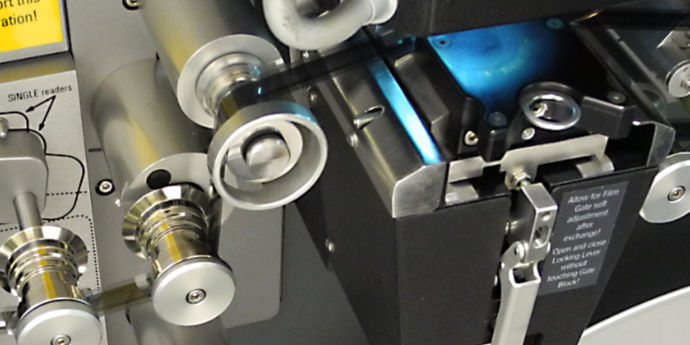With four scans under our belt, let’s take a look at them in more detail as an aid to planning how best to restore them for DVD release.
The first thing to note is that all four scans have “2K” resolution — 2048 pixels wide by 1556 pixels high. That’s a lot more resolution than is needed to reproduce the detail on the film.
As explained in an earlier post1:
The Australian black and white television system circa 1960 delivered 25 television “frames” per second. Each television frame had 625 scan lines. These 625 scan lines were split between two “fields”, with two successive fields making up each frame (hence 50 fields per second). Consequently each field contained only half of the 625 scan lines for each frame — i.e. around 300 scan lines per field.
The GTV9 film recording system captured only every second “field”. This meant actual vertical resolution of less than 300 lines.
Scanning 1556 pixels vertically means we have about five times the vertical resolution of the images on the film!
We also have “overscan”, meaning that the area scanned extends beyond the edges of the video raster recorded on the film. This will be to our advantage when it comes to digital restoration of the film images and determining the optimal cropping boundary.
Here’s a frame grab from one of the scans with some annotations.

Video Line Structure
These kines were recorded on a machine comprising in essence a 16mm film camera positioned in front of a cathode ray tube (CRT) display1. The electron beam in the CRT traces out a series of luminous horizontal lines on the face of the tube. The camera lens images this pattern of scan lines — called a video raster — onto the film.
Using the extra resolution of these digital scans, let’s zoom in for a closer look at the raster structure on each kine. The magnification on each of these images is roughly the same. The 1959 kine was scanned on the ScanStation, while the remaining three were scanned on the Spirit Datacine.

Notice that scan line structure is slightly different on each kine. Individual scan lines are not visible on the 1959 kine. The 1961 kine on the other hand shows distinct scan lines with darker bands between each. On the 1962 kine, the scan lines are wider and merge together so you can hardly discern individual lines.
These variations serve as a reminder that the analog television system did not have the precision of the digital systems of today. There were lots of variables. Adjustments were constantly required to keep everything working correctly.
Positive vs. Negative Film Recordings
In the earlier blog post1 I quoted former GTV9 engineer Ian Douglas saying:
We originally recorded direct positives using a negative image on the CRT, and that gives only one copy. We could also make negatives by putting a positive image on the CRT … and then get the film laboratory to run positives from the master negative.
For a negative film stock, areas which are exposed to light turn dark when processed. Areas which are not exposed to light remain transparent.
The film edges outside the camera gate aperture are shielded from exposure to light. Hence on the original camera negative these edge areas will be transparent. When duplicated at a laboratory onto another negative stock, the clear areas will transmit light and hence appear black in the duplicate.
These four kine scans exhibit both: (i) first-generation “direct positives” and (ii) prints made from negatives. How can we tell which is which?
We can assume that a kines with transparent edges must be an original camera negative. A positive image was recorded onto the film by displaying a “negative” or inverted video image on the CRT.
Conversely, kines with black film edges must be prints made from camera negatives. In this case the CRT image would not be inverted.
The 1959 kine is the only direct positive. The kines from 1961 to 1963, appear to be prints made from a camera negative. By that stage distribution of these productions to country television stations was probably occurring — hence the need for multiple copies on film (videotape was still prohibitively expensive for regional television stations).
Artefacts of the Kine Film Recorder
The only other thing worth noting is the little black circles in each corner of the kine frame (see above diagram). These appear to be artefacts of the kine system. They are stable relative to the video raster. On the kines recorded to negative, these circles are white instead of black. They are not present on all the kines and vary in their appearance.
1. See the earlier post in this series titled “About the GTV9 Film Recording System Circa 1960”
